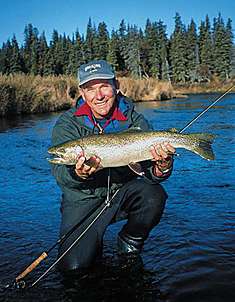|
Learning To Fly

By Joe Doggett
Page 2
I alternated between the fly
rod and a Zebco 33 spincast rig for four or five years before
embracing the joys of serious levelwind bait casting. For many
of today's anglers, the metamorphosis is reversed. Years of "plugging"
are exchanged, or at least augmented, by the fresh approach of
fly casting. Whatever. The tight loop works as well coming from
either direction.
The bottom line is that a fly
rod is a highly efficient tool under the right circumstances.
It can deliver a realistic surface or sub-surface offering with
a soft presentation, obtaining a level of finesse that "chunk
and wind" casting cannot match. As another advantage, the
fly caster can "pick up" and shoot a fresh line without
having to retrieve all the way to the rod; this quick-fire capability
saves time along defined edges of fish-holding cover. You work
the retrieve thorough the narrow kill zone, then pick up for another
presentation-fast and efficient, especially when surface weeds
or similar obstacles might block a conventional cast. This ability
to abruptly lift the line also is an advantage following an obviously
off-target shot, or when a sighted fish changes directions.
Under various circumstances
in fresh and saltwater, the fly rod is not just an acceptable
way to cover the situation-it is the best way. Utilizing a long
rod expands the potential of the versatile angler. Some rabid
devotees become so obsessed that they use nothing but fly rods.
That's never been me. I have never believed in carrying a fly
rod where it doesn't want to go. Probing near the bottom in a
deep hole or channel comes to mind. So does blind casting across
a monotone expanse of bay. These situations require too much heave-ho
work. No-the fly rod needs defined targets. But, whenever fish
are cruising shallow, or feeding near the surface, or holding
around visible cover, the long rod can be a great call.
In this, Texans are fortunate
to have legitimate fly-fishing opportunities in saltwater as well
as inland. Miles of clear, shallow bay flats and back "lakes"
are within reach of double hauls all along the middle and lower
coast. Under "ice cream" conditions, sight casting to
cruising or tailing redfish (even large speckled trout) is the
order of the day. This year-round saltwater fishery has proven
to be a big shot in the casting arm for the fly-fishing momentum
in Texas. Freshwater bass or saltwater reds-the same 8-weight
outfit can cover the water.
Today's X-generation graphite
rods are far superior to the old glass Wonder Rod, but the 8-weight
remains the go-to stick, the most versatile for all-around fresh/salt
duty. I have several dozen fly rods, from meaty 12's to dainty
3's but, if pared to a single choice, I would not hesitate to
grab an 8. There's not much this side of the heavyweight marine
species that old "ocho" cannot handle; it has the power
to cast larger 4- and 5-inch streamers and the finesse to present
smaller bugs and flies.
Fly water is found in the most
pleasing places, and travel is one of the great rewards of the
sport. You may learn here, on bass and bream, maybe reds and specks,
but the exotic places beckon. So many wonderful experiences wait
within reach of a double haul or an upstream mend. You cannot
do it all, although some of us continue to try. During the past
25 years I have fly fished from Alaska to Argentina, Russia to
the Rockies, Christmas Bay to Christmas Island.
I am a global nomad. I am in
position to pursue this quest, and intend to continue as long
as I am able. I spend thousands of dollars and weeks of vacation
each year in search of excellent fly fishing. Yet, despite this
far-flung passion, new experiences with the long rod can be found
almost literally under foot. All you have to do is look with open
eyes. Recently, I enjoyed several intense sessions with a 6-weight
while stalking carp in the bayous of Houston. I mean, right in
the city, walking the man-made "flats" of the concrete
channels and sight casing with small popping bugs to 5- and 6-pound
fish cruising with their backs out of the water. Make the right
presentation, and now and then one would eat. Scoff if you will,
but the drill combined the high qualities of bonefish and trout
within sight and sound of the 610 Loop rush-hour traffic.
Near or far, the fly rod can
take you to special places, and pure fishing is a sport you can
follow into old age. Some years ago, deep in Costa Rica, I watched
the great fly fisherman Lee Wulff play a sailfish on a 9-weight
rod and clicker reel. He was 85. That's what I want-to play the
game with style and staying power.
The long-ago Wonder Rod was
a special gift, a springboard into the world of fly fishing. It
suffered wind knots and tailing loops on fledgling forays to the
Hermann Park duck pond, but survived to point the way to grand
horizons. The rod broke in 1975 on, of all things, a 1-pound white
bass below the Lake Livingston Dam. The line was stripping smoothly
against the struggling fish when the tip section snapped. One
moment, the rod was filled with life and flex, then the lights
went out; the magic was gone.
The first fly rod just wore
out; but not before it gave me everything it had.
# # # #
page 1 / page 2
|





